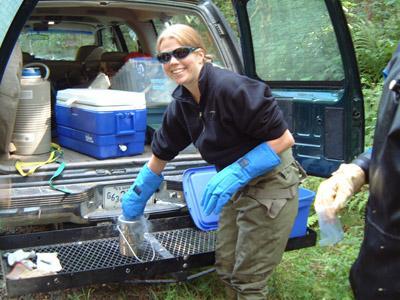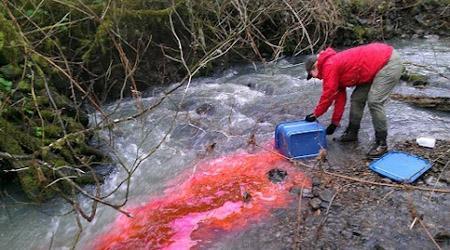Meet EPA Ecologist Jana Compton, Ph.D.

Identifying Sources of Excess Nitrogen
As an ecologist with the Western Ecology Division of EPA’s Office of Research and Development, Dr. Jana Compton investigates the sources and effects of nitrogen pollution. She obtained her undergraduate degree in biology and chemistry at Earlham College, earned her graduate degrees in forest ecosystems and biogeochemistry at the University of Washington, and then completed her post-doc work at Harvard Forest. Before joining EPA, Dr. Compton worked as an Assistant Professor of Soil Biogeochemistry at the University of Rhode Island.
How does your science matter?
I work on identifying the sources of nitrogen pollution. Small quantities of nitrogen are essential for living things, but too much nitrogen is harmful to ecosystems. My research focuses on non-point sources of nitrogen pollution, for example, land use and agriculture. I connect these sources to their impacts, and quantify them in ways that people can understand. This helps to address major problems like air quality, and problems we see in water ways such as eutrophication and coastal hypoxia.
Also, by looking at the social and economical impacts of nitrogen pollution, we can help people to recognize how it might be affecting the benefits we all get from healthy ecosystems, what we call “ecosystem services,” such as clean air and safe drinking water.
If you could have dinner with any female scientist, past or present, who would it be and what would you want to ask them?
I’d like to talk to Sandra Steingraber, whom I consider a modern day Rachel Carson. She is an author that connects ecology, the environment, and human health. She had a really personal story, and I think a lot of women go into their field because of personal things that may have happened to them.
She tried to understand her role in the environment and the impact that it has had on her environment and on children. She’s someone I’d like to sit down and talk with about our world and the chemicals that are out there, how they are affecting our children, and what we can do to make things better.
When did you first know you wanted to be scientist?
I knew I wanted to be a scientist in college when I had the chance to work in a research environment. I worked at Oak Ridge National Lab for a summer and saw what scientists there did and the way they asked interesting questions and then worked to answer them. The experience really pointed me in that direction.

Tell us about your background.
My background starts with growing up in Oak Ridge, Tennessee, one of the places where they worked on the Manhattan Project developing an atomic bomb in the 1940s. Growing up in that environment, it’s hard not to think about the mostly invisible chemicals and how they affect you. From radiation to the coal-fired power plant that I could see from my house, those were things that I thought about as a kid while I caught crawdads in our backyard creek.
I think those kinds of things set me on the path to be an environmental scientist. I went to Earlham College for my undergraduate study. There was a great combination of ecology and one of my inspirations was a chemistry professor, Wil Stratton. I learned about acid rain from him. That was the first thing that really pushed me toward environmental science, and I still work on related issues here at EPA. I got my graduate degrees, both my masters and my PhD, at the University of Washington in forest and forest ecosystems. Then I worked at Harvard University as a post-doc. All of those were great experiences and kept me moving toward the kinds of things that I am doing now.
What do you like most about your research?
I like getting to work with people who are also really excited about what they are doing. I have a lot of great colleagues who are interested in nutrients and chemistry and all kinds of exciting topics so it's a great research environment.
If you were not a scientist, what would you be doing?
This is a hard question! I just went in to my daughter’s classroom and taught a bunch of 3rd graders about geology and geologic time. That was really fun to do. It would be hard work to be a teacher, but maybe that would be something I could do instead of science.
Any advice for students considering a career in science?
I think the 95% perspiration and 5% inspiration rule applies here! You need to love what you do because it will require a lot of hard work.
